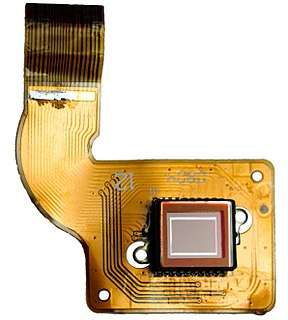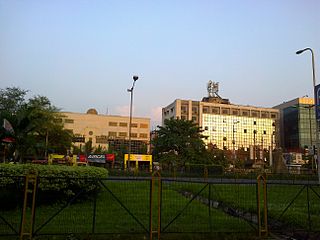In signal processing, data compression, source coding, or bit-rate reduction is the process of encoding information using fewer bits than the original representation. Any particular compression is either lossy or lossless. Lossless compression reduces bits by identifying and eliminating statistical redundancy. No information is lost in lossless compression. Lossy compression reduces bits by removing unnecessary or less important information. Typically, a device that performs data compression is referred to as an encoder, and one that performs the reversal of the process (decompression) as a decoder.

In digital imaging, a pixel, pel, or picture element is a physical point in a raster image, or the smallest addressable element in an all points addressable display device; so it is the smallest controllable element of a picture represented on the screen.
Digital image processing is the use of a digital computer to process digital images through an algorithm. As a subcategory or field of digital signal processing, digital image processing has many advantages over analog image processing. It allows a much wider range of algorithms to be applied to the input data and can avoid problems such as the build-up of noise and distortion during processing. Since images are defined over two dimensions digital image processing may be modeled in the form of multidimensional systems. The generation and development of digital image processing are mainly affected by three factors: first, the development of computers; second, the development of mathematics ; third, the demand for a wide range of applications in environment, agriculture, military, industry and medical science has increased.
Imaging is the representation or reproduction of an object's form; especially a visual representation.
A digital image is an image composed of picture elements, also known as pixels, each with finite, discrete quantities of numeric representation for its intensity or gray level that is an output from its two-dimensional functions fed as input by its spatial coordinates denoted with x, y on the x-axis and y-axis, respectively. Depending on whether the image resolution is fixed, it may be of vector or raster type. By itself, the term "digital image" usually refers to raster images or bitmapped images.

Lenna or Lena is a standard test image widely used in the field of image processing since 1973. It is a picture of the Swedish model Lena Forsén, shot by photographer Dwight Hooker, cropped from the centerfold of the November 1972 issue of Playboy magazine. The spelling "Lenna" came from the model's desire to encourage the proper pronunciation of her name. "I didn't want to be called Leena []," she explained.
SPIE is an international not-for-profit professional society for optics and photonics technology, founded in 1955. It organizes technical conferences, trade exhibitions, and continuing education programs for researchers and developers in the light-based fields of physics, including: optics, photonics, and imaging engineering. The society publishes peer-reviewed scientific journals, conference proceedings, monographs, tutorial texts, field guides, and reference volumes in print and online. SPIE is especially well-known for Photonics West, one of the laser and photonics industry's largest combined conferences and tradeshows which is held annually in San Francisco. SPIE also participates as partners in leading educational initiatives, and in 2020, for example, provided more than $5.8 million in support of optics education and outreach programs around the world.

An image sensor or imager is a sensor that detects and conveys information used to make an image. It does so by converting the variable attenuation of light waves into signals, small bursts of current that convey the information. The waves can be light or other electromagnetic radiation. Image sensors are used in electronic imaging devices of both analog and digital types, which include digital cameras, camera modules, camera phones, optical mouse devices, medical imaging equipment, night vision equipment such as thermal imaging devices, radar, sonar, and others. As technology changes, electronic and digital imaging tends to replace chemical and analog imaging.
Gary Joseph Sullivan is an American electrical engineer who led the development of the AVC, HEVC, and VVC video coding standards and created the DirectX Video Acceleration (DXVA) API/DDI video decoding feature of the Microsoft Windows operating system.
Stereoscopic Displays and Applications (SD&A) is an academic technical conference in the field of stereoscopic 3D imaging. The conference started in 1990 and is held annually. The conference is held as part of the annual Electronic Imaging: Science and Technology Symposium organised by the Society for Imaging Science and Technology (IS&T).

Alan Conrad Bovik is an American engineer and vision scientist. He is a Professor at The University of Texas at Austin (UT-Austin), where he holds the Cockrell Family Regents Endowed Chair and is Director of the Laboratory for Image and Video Engineering. He is a faculty member in the UT-Austin Department of Electrical and Computer Engineering, the Institute for Neuroscience, and the Wireless Networking and Communications Group.
Scene statistics is a discipline within the field of perception. It is concerned with the statistical regularities related to scenes. It is based on the premise that a perceptual system is designed to interpret scenes.

B.P. Poddar Institute of Management and Technology or BPPIMT is an undergraduate college in West Bengal, India. It was established in 1999 by B.P. Poddar Foundation for Education. The college is affiliated with Maulana Abul Kalam Azad University of Technology and all the programmes are approved by the All India Council for Technical Education and the courses C.S.E., E.C.E., E.E., I.T. are accredited by NBA.

Nasir Ahmed is an Indian-American electrical engineer and computer scientist. He is Professor Emeritus of Electrical and Computer Engineering at University of New Mexico (UNM). He is best known for inventing the discrete cosine transform (DCT) in the early 1970s. The DCT is the most widely used data compression transformation, the basis for most digital media standards and commonly used in digital signal processing. He also described the discrete sine transform (DST), which is related to the DCT.

The University of Engineering & Management (UEM), Kolkata is a private university located in New Town, Kolkata. It provides engineering, technological & management education. It was established in 2015 by IEM Trust, Act no. XXV and it is the third engineering institution founded by the IEM-UEM Group. This university is administrated by the Institute of Engineering and Management (IEM) education group trust.
Anurag Sharma is an Indian physicist and a professor at the Department of Physics of the Indian Institute of Technology, Delhi. He is known for his pioneering researches on optoelectronics and optical communications and is an elected fellow of all the three major Indian science academies viz. Indian Academy of Sciences, Indian National Science Academy and National Academy of Sciences, India as well as Indian National Academy of Engineering. The Council of Scientific and Industrial Research, the apex agency of the Government of India for scientific research, awarded him the Shanti Swarup Bhatnagar Prize for Science and Technology, one of the highest Indian science awards for his contributions to Engineering Sciences in 1998.
Peter Trefonas is a DuPont Fellow at DuPont, where he works on the development of electronic materials. He is known for innovations in the chemistry of photolithography, particularly the development of anti-reflective coatings and polymer photoresists that are used to create circuitry for computer chips. This work has supported the patterning of smaller features during the lithographic process, increasing miniaturization and microprocessor speed.
Edmund Y. Lam is a Chinese professor and associate dean of engineering at the University of Hong Kong.
Lina J. Karam is a Lebanese-American electrical and computer engineer. She is an IEEE Fellow and the Editor-in-Chief of the IEEE Journal of Selected Topics in Signal Processing. Her areas of work span digital signal processing, image/video processing, coding and transmission, computer vision, machine learning, and perceptual-based visual processing.
Fauzia Ahmad is an associate professor of electrical engineering at Temple University. Her research considers statistical signal processing and ultrasonic guided wave structural health monitoring. She serves as associate editor of the IEEE Transactions on Aerospace and Electronic Systems and Geoscience and Remote Sensing Society. She is a Fellow of the Institute of Electrical and Electronics Engineers and SPIE.





